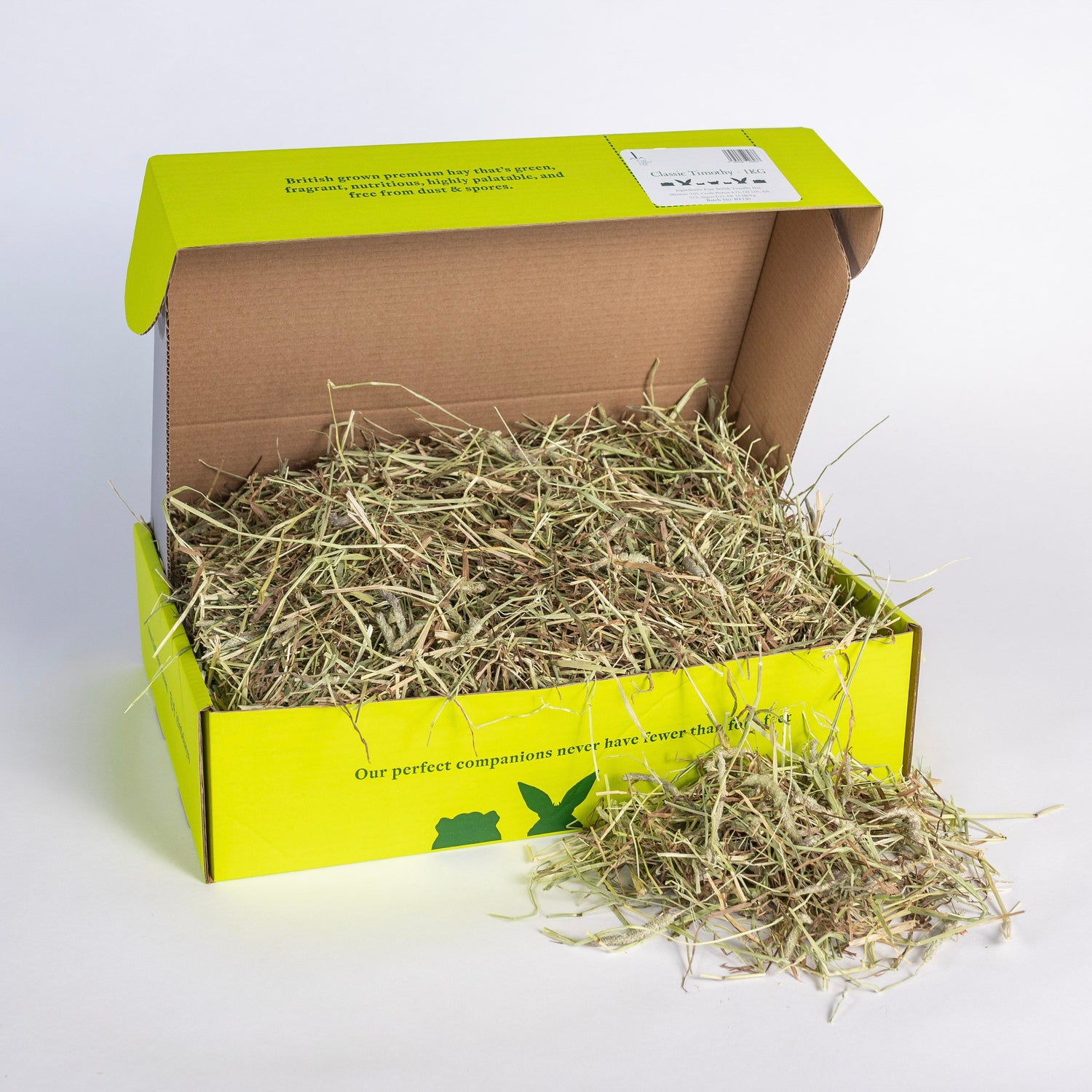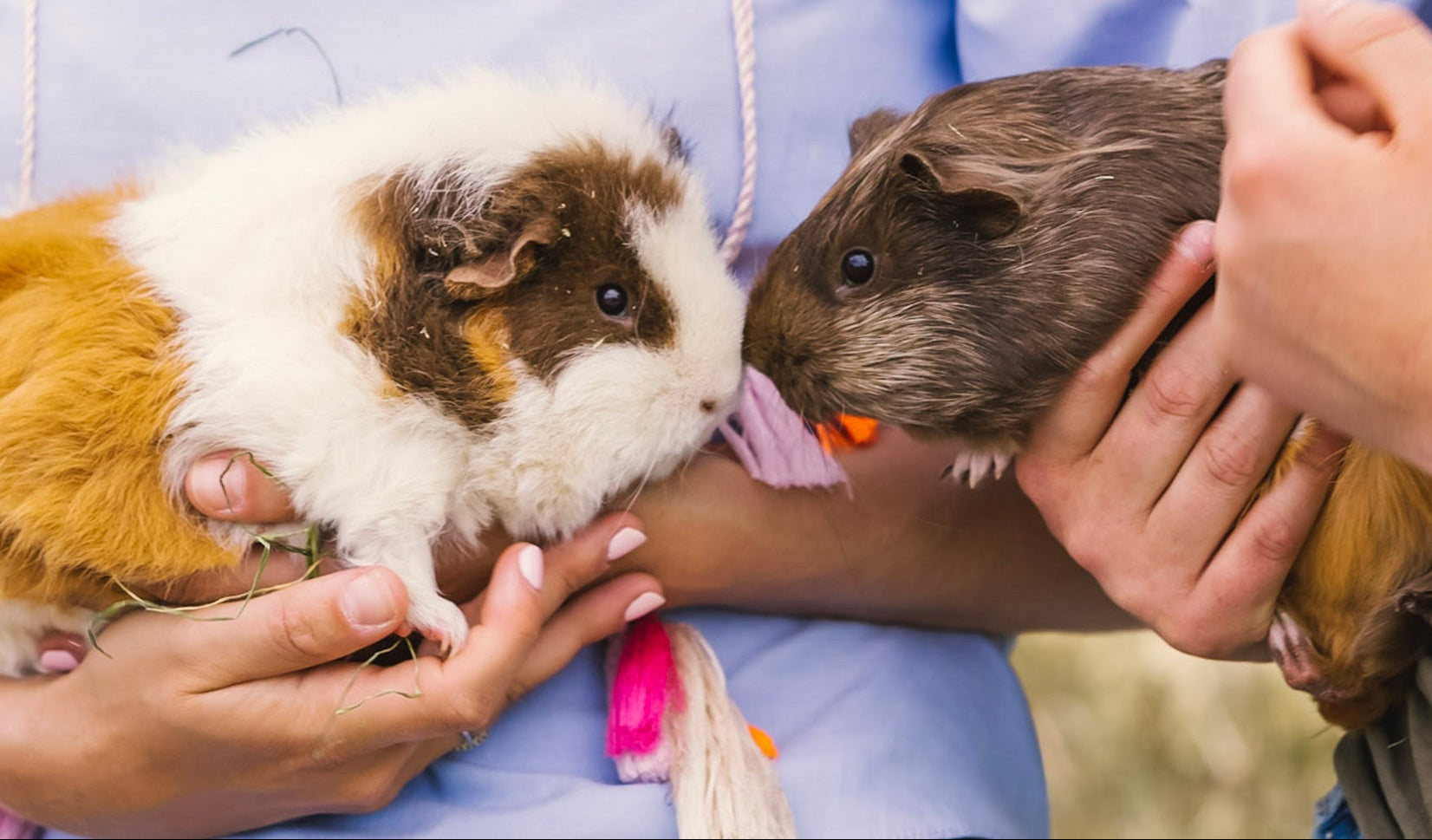Guinea pigs love hay. It is crucial for their health and happiness. Not only is it a food source, but certain hay can be used as bedding too. Choosing the right hay for your guinea pig will help them live a long and happy life.
What is the best hay for Guinea Pigs?
The popular feeding hay for guinea pigs is Timothy Hay, Rye Grass or Silky Soft Hay. Both of these hays offer benefits to your guinea pig, so it can be a case of finding out which your guinea pig prefers.
Why is hay so important for guinea pigs?
Hay is important for guinea pigs as it offers them all they need to stay healthy. Hay helps guinea pigs keep their teeth from growing too long, as the tough stalks wear them down. Hay also gives them all the fibre they need, which is important for good digestive health.
You can never give a guinea pig too much hay, but you should always buy the best quality hay for them. Guinea pigs can be badly affected by dust, so look for dust-free hay. The Little Hay Co specialise in making hay with minimal dust.
What to look for in a good guinea pig feeding hay
The most important thing to look for in hay is quality. Cheaper hay can be a false economy as you can run into problems with your guinea pig’s health down the road. There is a range of different hay types available. The most common hay given to guinea pigs is Timothy Hay, Rye Grass, Meadow Hay or Orchard.
Timothy Hay
Timothy Hay has long soft stems with soft full flower heads. This hay is high in fibre, green in colour and fragrant. It is one of the most popular hay types for guinea pigs.
Rye Grass Hay
Rye Grass Hay has long course strands, is green in colour, fragrant and high in protein. This makes it an excellent choice for benefitting teeth health and general wellbeing.
Orchard Grass Hay
Characterised by a sweet smell and overall soft texture that encourages consumption.
Meadow Hay
Usually, soft-stemmed native grasses often include other small edible plants like dandelions, daisies and thistles.
Oat Hay
This hay is high in protein and energy but is usually only fed to horses and cattle. Mixed hay bags for smaller animals can include Oat Hay.
Wheat and Barley Hay
If harvested before the seed heads ripen, wheat hay and barley hay can be used as a feedstock for larger animals. Mixed hay bags for smaller animals can include Wheat and Barely Hay.
Alfalfa hay
This hay has a higher protein content than ordinary grass hay, which means it is not an ideal feedstock for adult guinea pigs as it is too fattening. Alfalfa Hay can be fed to young piggies to help them grow or to new Mum’s who need a little extra help.
Herbal Hay
Herbal Hay includes other elements found in the natural environment. Trace elements of other plant-based nutrients in the hay can be more enjoyable to eat than one hay type alone.
Mixed Hay
This is where popular hay types are combined to more closely mimic what you would find in the wild. Our specially mixed Hay contains Rye Grass Hay, Timothy Hay and Seeds Mixture Hay.
Timothy Hay vs Rye Grass vs Meadow Hay
Timothy Hay is made up of the stalk, leaf and seed head. The leaf contains vitamins and minerals, the stalk helps wear down your guinea pig’s teeth and as it is full of fibre it aids digestion too. The seed head is very tasty, guinea pigs love them.
Rye Grass Hay is slightly softer staked than the Timothy Hay but tastier and still retains a tasty seed head. It needs to be cut early to avoid it being too mature.
Meadow Hay comes from different sources, harvested in the pastures. This means it contains grasses, plants, flowers and seed heads. As it is created from multiple sources, it does contain a wider range of minerals than single grass hay. It may miss having as many tough stalks, which help with their teeth length and health. Guinea pig owners often mix the two hays to add variety but favour one as the main staple diet.
Hay comparison table
Nutritional Breakdown of Hay & Grass:*
| Hay Type | Crude Fibre | Crude Protein | Calcium |
| Orchard Grass | 34% | 10% | 0.33% |
| Timothy Hay | 32-34% | 8-11% | 0.4-0.6% |
| Oat | 31% | 10% | 0.4% |
| Dried Grass | 22-28% | 12-14% | 0.55% |
| Meadow | 33% | 7% | 0.6% |
| Alfalfa | 28-34% | 13-19% | 1.2-1.4% |
| Bermudagrass | 29% | 10% | 0.46% |
Does guinea pig hay have to be dust-free?
It is virtually impossible to find 100% dust-free hay, but you can come very close. The Little Hay Co have a specialised hay collection and packing method that reduces dust to a bare minimum. This has huge benefits for guinea pigs as they can be adversely affected by dust which causes respiratory problems. Keeping your hay dry also prevents dust, as damp hay will actually become dusty and then fungal spores will seek out the hay, causing even more issues to your guinea pig.
Do guinea pigs need a hay feeder?
Bedding hay is usually kept separately from feeding hay. It is much better to keep your guinea pigs bedding hay different from feeding hay. Bedding hay is usually softer, whereas feeding hay can have a variety of strengths. Keeping the two apart will avoid things like hay poke, where your poor little guinea pig is minding its own business foraging around the hay, only to be poked (usually in the eye) by a strong stalk. This will likely end with a trip to the vets. The other obvious reason to do this is cleanliness. Mixing food and bedding will not be very hygienic for your little friend. Little Hay Co Super Silky Soft Hay is an ideal bedding hay.
If you use a hay feeder for guinea pigs, you can keep feeding hay and bedding hay separate.
What do first, second and third cuttings mean?
The three cuts of Hay are the first cut, second cut and third cut. The first cut has the highest fibre rating but is lower in nutritional value, it is also the roughest of the cuts. The second cut is more balanced between fibre and protein. The third cut is softer and greener with less fibre but more protein.
What is Alfalfa hay and is it good for guinea pigs
Alfalfa hay has a higher protein content than ordinary grass hay, which means it is not an ideal feedstock for adult guinea pigs as it is too fattening. Alfalfa Hay can be fed to young piggies to help them grow or to new Mum’s who need a little extra help.
How to feed a guinea pig
You should feed your guinea pig a premium feeding hay or grass. This should make up 85-90% of their main diet.
Vitamin C
Guinea pigs cannot make Vitamin C, so their food source must give them the trace amounts they need. A guinea pig needs around 25mg of Vitamin C per day. Supplying a mix of fresh greens and vegetables each day can provide this and will help them stay healthy.
Fresh Water
All animals need a source of freshwater to survive and prosper. Daily water changes will help make sure your guinea pig stays fit and healthy.
Good bacteria
A healthy balanced diet and lifestyle is all your piggy needs to stay healthy. You can help their immune system with ‘good bacteria’ supplements if needed.
Fresh veg and what veg not to eat
Fresh greens including broccoli, spinach and cabbage are excellent food to give your pig. Carrots also are a nice treat to give them on occasion. You should not feed your piggie potatoes, rhubarb or tomato leaves.
Premium grass pellets
You can supplement your piggy’s diet with premium grass pellets to help with their Vitamin C and other nutrient intakes. It is best to avoid pellets that also include fruit or flakes and go for a pure grass-based, Timothy Hay pellet.
A small handful can be given daily. If pellets are left for longer, their goodness will fade. Keep removing uneaten old pellets and replace them with new fresh ones.
Plants to avoid for guinea pigs
There are a few plants to avoid for your guinea pig. These include daffodils, lilies, nightshade, oak, rhubarb leaves, tomato leaves, foxglove, privet and onion grass.
How much should I feed my guinea pig
Guinea pigs can never have too much hay. Though there is a difference between bedding hay and feeding hay. Feeding hay should be provided at least the same size as the guinea pig every day. Bedding hay should also be changed daily for hygiene reasons.
Can I use feeding hay for bedding
Feeding hay is designed to give your guinea pig everything it needs to be healthy and happy. The fibre it contains will help with digestion, the stalks keep their teeth from growing too long and it is full of other nutrients that help promote a balanced diet.
If you use your feeding hay as bedding, then it will be used for exactly that, which means your guinea pig will be eating hay that has been trodden on and used for their toilet too. Far better to use a guinea pig feeder and keep the feeder hay separate.
My guinea pig is not eating hay. What should I do?
Don’t panic. Sometimes a piggy will just have a break, but if it continues to avoid hay, then you need to take action. A guinea pig needs to use its stomach constantly or problems arise. If they stop eating, then their intestines will stop working soon after. You can try a different hay type to assess whether it is the hay they have stopped enjoying and maybe a new type will spark up their interest again.
However, guinea pigs do like hay and it's recommended that 85-90% of their diet is hay-based, so if they have stopped eating hay, it can indicate there is a problem and you should take them to be checked at your veterinary clinic.
Guinea pig health check
The best thing you can do is get to know about your guinea pig by learning their routines and normal behaviour. Then you will be able to notice if anything is wrong or out of the ordinary.
Simple daily checks of their face and eyes are easy, make sure their eyes are bright and open, they don’t have a runny nose, red or weepy eyes. When looking at their mouth make sure it is closed with no teeth sticking out.
Look inside their ears to check for wax build-up or any sign of infection. Check their fur is not matted, tangled or clumped, it should be clean and shiny with no bald patches. Have a look at their feet to check they can move freely, and their nails are not too long and curling underneath.
In terms of their weight, look out for big weight loss or weight gain, especially in a short period.
If in any doubt, seek expert advice if you suspect something is wrong. As Guinea Pigs are prey animals, they might hide illness or pain to avoid being seen as weak, so keeping a keen eye on them and their behaviour will help you nip anything in the bud nice and early.













